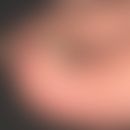Synonym(s)
DefinitionThis section has been translated automatically.
Frequent, etiopathogenetically heterogeneous, itchy and painful dermatitis of the hands with acute, subacute or (frequently) chronic (see below hand dermatitis, chronic) course and varying degrees of severity. Hand eczema has a high health economic and socio-medical significance with frequent and possibly long-lasting incapacity to work.
A special feature of chronic hand dermatitis in particular is its occupational dermatological relevance (around 52% of all dermatitis of the hands is classified as work-related; see also occupational skin disease below).
ClassificationThis section has been translated automatically.
Hand eczema (foot eczema) can be categorized according to temporal, etiopathogenetic (atopic, contact allergic, irritant) or purely clinical aspects (hyperkeratotic, hyperkeratotic-rhagadiform, dyshidrotic).
A distinction can be made according to the acuteity of the "eczema reaction":
- Acute hand dermatitis(dyshidrotic hand eczema, pompholyx)
- Subacute hand eczema
- Chronic hand eczema
Taking into account the etiology (allergic, irritant), the following classification can be made:
Allergic:
- Hand eczema, contact dermatitis, allergic (evidence of clinically relevant contact sensitization by type IV and/or type I allergens) or in the case of atopic diathesis.
- Dermatitis, contact dermatitis, allergic (positive patch test and contact with the allergen)
- Protein contact dermatitis
- Atopic hand dermatitis (with the minus variants: dermatitis hiemalis/atopic winter feet, pulpitis sicca, dyshidrosis lamellosa sicca)
Irritant:
- Hand dermatitis, cumulative-toxic contact dermatitis (exclusion diagnosis in exogenously triggered, acute or chronic dermatitis of the hands) often beginning in the interdigital spaces, spreading to the back of the hand; no sensitization; strictly limited to the site of exposure. Cumulative toxic processes are a partial cause of all hand dermatitis in > 80 % of cases.
Taking into account the clinical morphology, they can be classified as follows:
- Hyperkeratotic (tylotic) hand eczema
- Hyperkeratotic-rhagadiform hand dermatitis
- Dyshidrotic hand dermatitis (vesicular or bullous dermatitis of the palms (and soles) with intraepidermal vesicles or blisters, with prolonged scaling and rhagades)
- Nummular hand dermatitis
Classification according to localization (not common):
- Back of hand/back of foot
- Palms of hands/soles of feet
- Finger side edges/toe side edges
- Finger tip dermatitis/toe tip dermatitis/pulpitissicca
- Interdigital folds
- Wrist joints
You might also be interested in
Occurrence/EpidemiologyThis section has been translated automatically.
Estimates for the 1-year prevalence of hand eczema due to occupational exposure in the population vary between 6.7% and 10.6% (see below eczema, contact eczema, allergic). A high incidence rate is associated with female gender, contact allergies, atopic eczema and working in a humid environment.
Hand eczema is the second most common occupational skin disease in the food industry.
Evidence of a significant increase in prevalence among young people/adults at risk of occupational diseases (especially hairdressers, bakers, florists, tilers, electroplaters, dental technicians, machinists, workers in the metal industry, employees in healthcare professions, etc.) during their training phases.
In the hairdressing trade, the prevalence (depending on the study) is between 2.0 % and 8.5 % in the first year of training and between 9.8 % and 23.5 % at the end of training. In the metalworking industry, a cumulative incidence of around 23% was found over a period of 2.5 years. The 1-year prevalence among cleaning staff was around 46%.
EtiopathogenesisThis section has been translated automatically.
The (chronic, non-specific) hand dermatitis is an exclusion diagnosis, in which other dominant causes are clinically-allergologically excluded. Smokers are significantly more frequently affected than non-smokers.
LocalizationThis section has been translated automatically.
The back of the hand, palms, edges of the fingers, fingertips, webbed fingers and wrists are mainly affected.
ClinicThis section has been translated automatically.
Clinical signs and symptoms of chronic hand eczema include erythema, oedema, vesicle formation, hyperkeratosis, fissures, rhagades, itching and pain.
Acute hand eczema is characterized by acute redness, itching, vesicle and blister formation, depending on the cause and triggering agent.
HistologyThis section has been translated automatically.
S. u. Eczema.
DiagnosisThis section has been translated automatically.
The medical history of patients with hand eczema should include specific exposures (including leisure time, domestic and occupational stress, medication intake, nicotine and other noxious substances), the course over time and the patient's own allergological history, taking into account the Erlangen Atopy Score.
Both domestic and occupational exposures must be taken into account. This also includes information on the course of hand eczema during vacation, weekends and periods of incapacity for work.
During the clinical examination, an inspection of the feet and the entire integument is necessary in addition to the findings in the area of the hands.
Standard diagnostics to determine the atopy status should include an indicative prick test with the most common inhalation allergens.
Epicutaneous testing is the standard procedure for identifying type IV sensitizations as triggers of allergic contact dermatitis. Allergen selection should be based on the relevant recommendations and include the selection of exposure-specific allergens.
During the initial diagnosis, a mycological exclusion diagnosis is recommended.
If the clinical picture indicates the presence of psoriasis, histological confirmation of the diagnosis should be sought, as this is essential for long-term treatment planning.
Differential diagnosisThis section has been translated automatically.
Psoriasis palmaris: sharply defined (!), red or white-grey, scaly, sometimes wart-like plaques on the palms; typically no spread to flexor forearms, no scattering phenomena; often also infestation of other predilection sites!
Tinea manuum: mostly fine-lamellar scaly, itchy plaques, also dyshidrotic vesicles or extensive hyperkeratosis (positive mycological evidence is often possible with appropriate efforts).
Lichen planus palmaris: usually in the context of an exanthematic lichen planus; on the palms of the hands, a flat hyperkeratotic pattern may occur that is atypical for lichen planus; diagnosis extrapalmar
Hereditary or symptomatic keratinization disorder of the palms of the hands and soles of the feet(keratosis palmoplantaris).
Pityriasis rubra pilaris: always with infestation of other skin areas
Palmo-plantar syphilide (see syphilis acquisita below): occurring as part of an exanthematic syphilide; always with skin changes on other areas of the skin as well
Complication(s)(associated diseasesThis section has been translated automatically.
Chronic dermatitis of the hands is often accompanied by nail changes. According to H. Hamm et al:
Irregular deformations of the nail plate with pits, dents, grooves, transverse furrows, roughening of the nail plate, thickening, onycholysis, dyschromia, paronychia (especially in atopic dermatitis of the hands)
General therapyThis section has been translated automatically.
The relevance assessment of identified type IV allergens is very important and if occupational triggers are identified, a review of the workplace and the possibility of replacing substances should be considered. Since allergic contact dermatitis can only be healed by consistently avoiding the triggering substances, patients must be fully informed about the type of contact allergens and their occurrence. If ingredients of topical products have been identified as contact allergens, allergen-oriented advice on skin protection and skin care measures is essential.
Rehabilitation as part of a measure to ensure employability (especially in the case of customer contact, industrial dermatoses, etc.). If necessary, skin protection training or, in the case of psychological involvement: behavioral medicine-oriented rehabilitation (VOR).
The same recommendations also apply to foot eczema (see: Notes).
External therapyThis section has been translated automatically.
- The therapy is based on the system, clinic and severity of the hand eczema. Mild hand eczema should be treated quickly, effectively and consistently to prevent it from becoming chronic. Chronic hand eczema is difficult to treat and requires complex management.
- When treating hand eczema, the general therapy principles of stage-appropriate eczema therapy must be observed as well as the etiology (atopic, allergic, irritant), the acuteity (acute vs. chronic eczema), the morphology (redness, scaling, lichenification, vesicles, hyperkeratosis, rhagades, etc.) and the localization (back of the hand, interdigital spaces, palms) of the skin symptoms. A prerequisite for successful therapy is the recognition and avoidance of causative exogenous factors (e.g. allergens, irritants).
- Hand eczema is treated according to a step-by-step concept:
- Basic therapy: Consistent moisturizing of the skin with products that are as free of preservatives and fragrances as possible, treat with compresses, lotions or creams in the acute stage, with ointments in the subacute stage and with fatty ointments in the chronic stage. Nourishing lipid-replenishing topicals in a compatible base such as Linola Fett N, Asche Basis-Salbe, Excipial Mandelölsalbe) or the application of a greasy, pale hand cream.
- Keratolytics: salicylic acid (up to 20%) and urea (5-10%), especially for chronic, particularly hyperkeratotic-rhagadiform hand eczema. Caution! Excessive or incorrect dosage, occlusion or simultaneous irritant exposure may cause skin irritation, redness and burning. If necessary, use a well-tolerated base with the addition of 2-10% urea (e.g. Basodexan ointment/fat cream, Excipial U Lipolotio, Linola Urea cream, Nubral cream).
- Glucocorticosteroids: The potency of the corticosteroid used and the duration of therapy depend on the severity of the hand eczema and the localization. Always combine with lipid-replenishing steroid-free local therapy. Systemic corticosteroids only in special cases. Do not use topical corticosteroids over a longer period of time. It is better to use sufficiently strong corticosteroids over a short period of time during an acute attack and then taper them off again quickly.
- Acute vesicular to bullous stage (weeping): Short-term glucocorticoids of medium to high potency in low-fat bases, hydrophilic creams or solutions such as triamcinolone cream 0.1 % R259, prednicarbate cream 0.25 % (e.g. Dermatop cream), mometasone 0.1 % (e.g. Ecural fat cream/solution) or clobetasol cream 0.05 % (e.g. Dermoxin cream). If necessary, apply moist compresses (NaCl) several times a day, in case of superinfection with antiseptic additives such as quinolinol (e.g. Chinosol 1:1000), R042 or potassium permanganate (light pink); caution! possible sensitization to disinfectants! In the vesicular stage also fat-moist with glucocorticoid, approx. 1 % hydrocortisone in lipophilic base R120, with a moistened dressing or cotton glove if necessary. In case of resistance to therapy, topical glucocorticoids with short-term occlusion.
- In the vesicular stage also fat-moist with glucocorticoid externa such as 1% hydrocortisone in a lipophilic base, with a moistened dressing or cotton glove if necessary. In case of resistance to therapy, apply topical glucocorticoids with intermittent occlusion (2x/day for 2 hours).
- Late crusty or squamous stage: Hydrophilic creams to regenerate the skin (e.g. base cream (DAC), Amciderm base cream, Asche base cream, Dermatop base cream). If necessary, also with "wound-healing additives" such as dexpanthenol (e.g. R064, Bepanthen Lotio). Local PUVA therapy can be helpful, initially 4x/week, maintenance therapy 2x/week.
- Topical calcineurin inhibitors: can be used to treat atopic hand eczema.
- Other local therapeutics: For superinfected eczema e.g. clioquinol (Vioform), chlorhexidine, etc., antiseptic additives such as quinolinol (e.g. Chinosol 1:1000) or potassium permanganate (light pink). Caution! Possible sensitization to disinfectants!
- For subacute to chronic eczema, preparations containing tar (e.g. Liquor carbonis detergens 5-10 %), Ichthyol or Tumenol 5-10 %, for hyperkeratotic-rhagadiform hand eczema Cignolin (Dithranol).
- Tap water iontophoresis: Tap water iontophoresis is the treatment of choice for existing hyperhidrosis and dyshidrosiform hand eczema.
Radiation therapyThis section has been translated automatically.
Cream or bath PUVA therapy: Particularly effective for chronic hand eczema. Initially 4x/week, maintenance therapy 2x/week.
Note! A combination of topical calcineurin inhibitors and UV therapy is not recommended.
Internal therapyThis section has been translated automatically.
ProphylaxisThis section has been translated automatically.
Rules of conduct for hand eczema:
- Avoid harsh cleaning agents for the hands (e.g. hand washing pastes) at work, in baby care or in the household.
- Avoid or wear protective gloves when handling water (e.g. when washing up) or for contact with aggressive substances (e.g. fruit, lemons, uncooked potatoes, tomatoes, aggressive cleaning agents, organic solvents, polishes, stain removers).
- In case of prolonged wet work with perspiration in the protective gloves: change gloves several times with a short break to dry off and put on cotton gloves.
- Do not wear rings when doing housework.
- Protect hands from the cold in winter and apply a particularly moisturizing cream.
Note(s)This section has been translated automatically.
The term "hand eczema" is initially only topographically descriptive. Like other topographically defined forms of eczema (e.g. eyelid eczema, anal eczema, lip eczema), it is justified by the clinical characteristics and the high socio-economic significance of these forms of eczema. The annual costs of chronic, occupational hand eczema are estimated at around EUR 9,000 per year (approximately the costs of moderate psoriasis vulgaris).
In principle, all the remarks made for hand eczema also apply to "foot eczema", which is not explicitly mentioned here.
Therapy costs: In a larger study, the average direct annual therapy costs for chronic hand eczema amounted to 1,742 euros per patient, the indirect (economic) costs to 386 euros,
The annual costs for chronic occupational hand eczema are estimated at around 9,000 euros per year (approximately the costs for moderate psoriasis vulgaris).
LiteratureThis section has been translated automatically.
- Augustin M et al. (2011) Medical costs in patients with chronic hand eczema in Germany. Abstract CD 46th DDG Conference, FV11/04
- Bryld LE et al. (2003) Risk factors influencing the development of hand eczema in a population-based twin sample. Br J Dermatol 149: 1214-1220
- Buhles N et al. (2023) Wisdom from the White Paper-Chapter 4.14: Rehabilitation in allergology. Allergo J 32: 16-24
- Buhles,N, E,A; L,H; S,S; T,A; W,J: Interdisciplinary S1-LL: Inpatient dermatologic rehabilitation. AWMF register no.: 013-083, on 3.12.2024
- DiepgenTL (2008) Chronic hand eczema. Dermatologist 59: 683-689
- Diepgen T et al. (1999) The epidemiology of occupational contact dermatitis. Int Arch Occup Environ Health 72: 496-506
- Grattan CE et al. (1991) Comparison of topical PUVA with UV-A for chronic vesicular hand eczema. Acta Derm Venereol 71: 118-122
- Hamm H et al. (2018) Diseases of the nails. In: Braun-Falco`s Dermatology, Venereology Allergology G. Plewig et al. (Eds.) Springer Verlag S 1400
- Heydorn S et al. (2003) Fragrance allergy in patients with hand eczema - a clinical study. Contact Dermatitis 48: 317-323
- Lehucher-Michel MP et al. (2000) Dyshidrotic eczema and occupation: a descriptive study. Contact Dermatitis 43: 200-205
- Molin S, Ruzicka T (2008) Alitretinoin. Dermatologist 59: 703-709
- Schäfer T (2003) Epidemiology of occupational hand eczema Allergology 26: 369-376
- Schnopp C (2002) Topical tacrolimus (FK506) and mometasone furoate in treatment of dyshidrotic palmar eczema: a randomized, observer-blinded trial. J Am Acad Dermatol 46: 73-77
- Skoet R et al. (2003) Contact dermatitis and quality of life: a structured review of the literature. Br J Dermatol 149: 452-456
- Stambaugh MD et al. (2000) Complete remission of refractory dyshidrotic eczema with the use of radiation therapy. Cutis 65: 211-214
- Uter W (1998) Prevalence and incidence of hand dermatitis in hairdressings apprentices: results of the POSH-study. Int Arch Occup Environ Health 71: 487-492
- Veien NK, Menne T (2003) Treatment of hand eczema. Skin Therapy Lett 8: 4-7
Incoming links (12)
Artichoke; Artichoke; Dexpanthenol cream hydrophilic 5% (nrf 11.28.); Hand dermatitis chronic; Hand eczema; Hydrocortisone cream 0.5-2.0% (w/o); Occupational dermatoses; Protein contact dermatitis; Quinolinol sulphate monohydrate solution 0,1 % (nrf 11.127.); Silver moss; ... Show allOutgoing links (27)
Alitretinoin; Atopic hand dermatitis; Atopic juvenile plantar dermatosis; Contact dermatitis allergic; Contact dermatitis toxic; Dexpanthenol cream hydrophilic 5% (nrf 11.28.); Dyshidrosis; Dyshidrosis lamellosa sicca; Dyshidrotic dermatitis; Early syphilis; ... Show allDisclaimer
Please ask your physician for a reliable diagnosis. This website is only meant as a reference.














